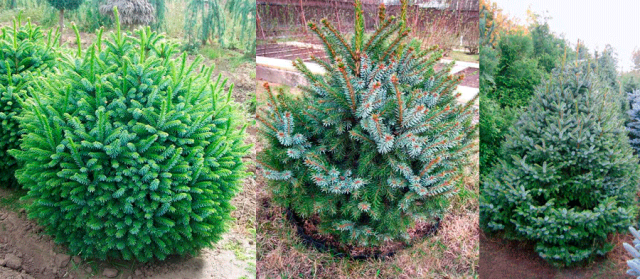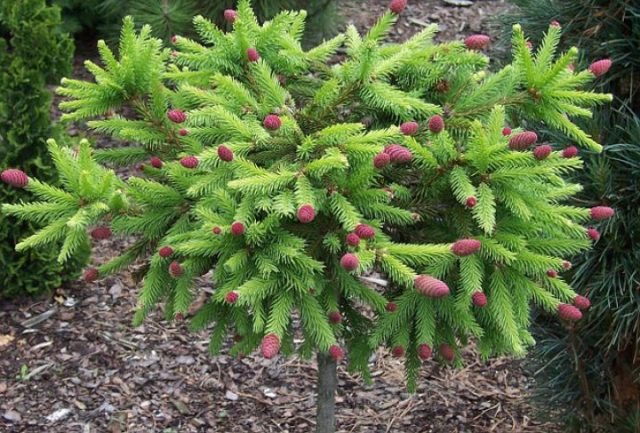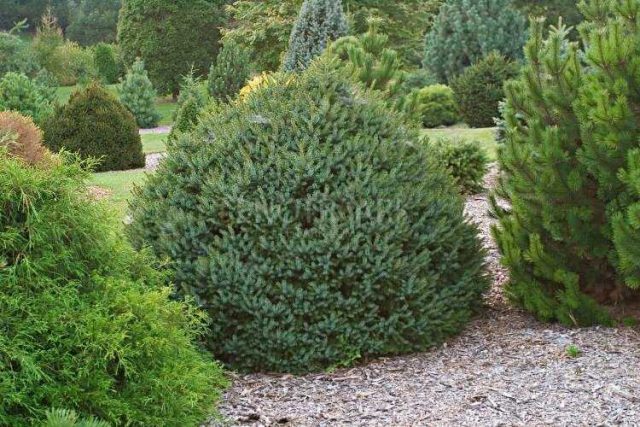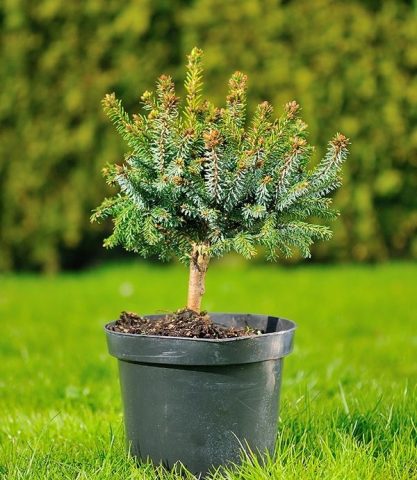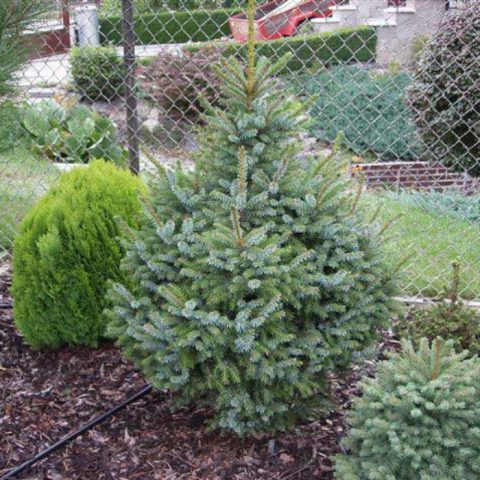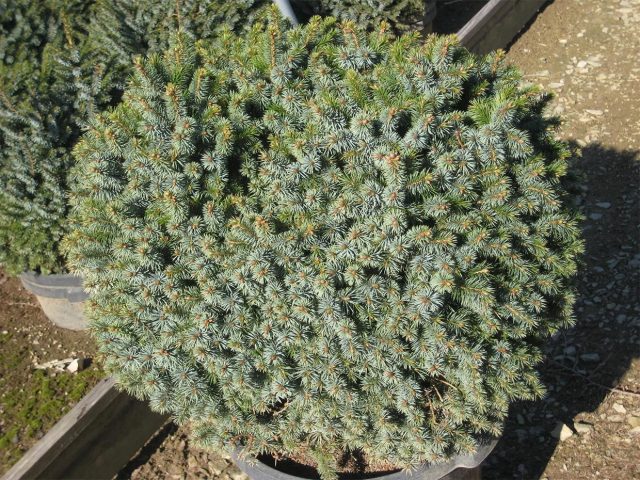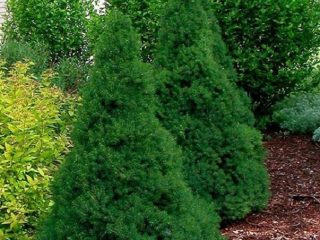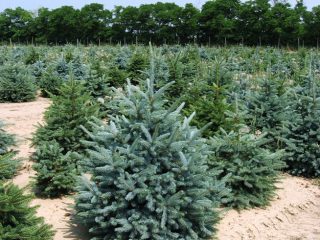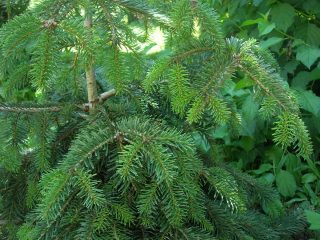Content
Serbian spruce Nana is a dwarf variety known since 1930. The mutation was discovered, fixed and polished by the staff of the Gudkade brothers' nursery located in Boskop (Netherlands). Since then, the Nana variety has become widespread and is grown in private and public gardens. It is especially popular in Europe and throughout Russia.
Description of ate Nana
Probably, the time has come long ago to divide coniferous dwarfs into at least two categories - those that grow really tiny, and that after a few decades will form rather large trees. Amateur gardeners are used to thinking that if the name of the variety contains the word Nana, the plant will be small. But this is not always the case.
Description and photos of the Serbian Nana spruce at a young age show a really charming, but not so small tree. Its height with good care in Western Europe reaches 1.5 m by the age of 10.For Russia and neighboring countries with a harsher climate and dense soils, these dimensions are much more modest - about 1 m.
But by the age of 30, the Serbian spruce Nana can stretch up to 3 m (in European countries - up to 4-5 m) with a crown diameter of 2 or 3-4 m, respectively.Over the season, the culture adds 5-15 cm in growth, in width it increases approximately 5 cm.
The shape of the crown changes with age. Ate is considered young up to 10 years old. At this time, the Nana variety has a rounded ovoid crown, very dense, with a weak leader. By trimming it, you can form a ball, a cone, placed on the blunt end of an ovoid. An adult tree gradually becomes looser, broadly conical, with a pointed top.
The branches of the Serbian spruce Nana are tough and short, densely pubescent. The length of the needles is less than that of the species plant, and is 7-8 mm, the width is 1.5 cm. The color of the needles is yellowish-green above, and blue below, which creates an interesting visual effect.
Cones form infrequently, but their appearance cannot be called a rarity. They are 3-6 cm long and spindle-shaped. As you can see in the photo of the Serbian Nana spruce on the trunk, at first the color of the cones is purple.
Then they change color to dark brown. The bark of the Serbian spruce Nana is flaky, reddish-gray. The root system is superficial. The trees are believed to live for over 100 years.
Use in landscape design
Conscientious manufacturers do not release conifers younger than 4 years old. This should be remembered by those owners who are engaged in the design of the site on their own, without the involvement of landscape designers. As well as the fact that the Serbian spruce Nana will stretch to 1-1.5 m by the age of 10, it will continue to grow faster, and will soon take its place among medium-sized trees, although it is considered a dwarf.
So, Serbian spruce should be placed on flower beds and beds with small plants only if they are supposed to have a large tree. Or when the owners like to constantly change and move something. But nevertheless, it must be borne in mind that after 10 years ate should be transplanted only as a last resort.However, the Nana variety will already form a rather large tree by this time, and it will be problematic to transfer it from place to place.
In rock gardens and rockeries, this Serbian spruce is inappropriate, since when transplanting, you will have to destroy the entire composition, dig up plants and turn out large stones. Unless the ensemble was originally made up of large cultures.
Harmoniously the Serbian spruce Nana will look in large and small landscape groups, single plantings. It is planted in alleys and at the front door. Can be used as a "family tree", decorated for the New Year.
Planting and caring for the Serbian spruce Nana
Serbian spruces are not as decorative as Canadian or thorny ones, but they behave much better in Russia - they take root faster, are less likely to get sick and are affected by insect pests, and require less care. But they cannot be left completely unattended. Serbian spruce is not intended for small-maintenance gardens and areas that are rarely visited by the owners (except that in the absence of the owners, the gardener will look after the plants).
Seedling and planting plot preparation
The plant is shade-tolerant, but forms a dense dense crown in an open sunny place, prefers loose acidic or slightly acidic loams. Serbian spruce Nana does not tolerate stagnant water, but its root system is superficial, so it will grow where other tree crops do well. It is enough not to place it in hollows and grooves, on permanently sealed dense soils.
It is not necessary to completely change the soil in the planting pit. It can be improved by adding:
- high-moor peat to neutral or alkaline soil, moreover, the higher the pH;
- clay is introduced into light sandy soil;
- on dense soils, a larger drainage layer is made and the structure is improved with leaf humus, red peat and sod land.
Depending on the age of the Serbian spruce Nana, it is required to add from 100 to 150 g of nitroammophoska to each planting pit.
When choosing seedlings, preference is given to those grown in a local nursery. You can buy them both in a plastic container and with an earthen lump trimmed with burlap.
The substrate and the earthen lump lined with burlap must be moist.
Standard trees are grafted, the overwhelming majority of them come from abroad. Particular attention should be paid to the place where cultures meet. The vaccine should heal well and not even show signs of damage: discoloration, cracks, wounds, rot or incomprehensible plaque.
The needles should be carefully examined to identify pests and signs of disease, damage to the bark or branches. The needles should be of a characteristic color for the culture, flexible. The presence of needles on 3-year-old branches is an indicator of the health and quality of the Serbian Nana spruce. You cannot buy a tree if at least some of the needles on the shoots at the age of 1-2 years have dried up. Even the red tips of the Serbian spruce needles are a sign of trouble, perhaps critical.
Landing rules
It is possible to plant containerized Serbian spruces of Nana at any time, but in the south in the summer it is better to refrain from this. If possible, the operation is carried out in warm regions from the beginning of autumn and throughout the winter. In cold weather, it is better to do it in the spring.
You need to prepare a pit for the Serbian spruce Nana in at least 2 weeks. Better yet, dig it up in the fall for spring planting and vice versa. The diameter of the pit should be 1.5-2 times the size of the earthen lump, the depth is the height of the container or earthen lump plus 15-20 cm for drainage and about 10 cm for filling the soil. You can make it more, less is undesirable.
Before planting, part of the soil is removed from the pit and laid, a seedling is placed in the center, carefully measuring the position of the root collar of the Serbian spruce Nana. It should be at the same level with the ground surface or slightly rise. Falling asleep with an earthen lump, the substrate is constantly rammed. Serbian spruce is abundantly watered and mulched.
Watering and feeding
The moisture content of the soil is most important for a newly planted plant. Watering is carried out regularly, not allowing the soil to dry out, but so as not to drown the Serbian spruce in the water. In this case, there is a high probability of root rot.
An adult tree is watered less often, consuming at least 10 liters of water per meter of growth. The top layer of soil should dry out a little between humidifications. It may be necessary to water every week in the hot summer.
Sprinkling the crown is of great importance. From time to time, and in hot summer - every day, Serbian spruce needs to be doused with water. If there is a fogging unit on the site, you will not have to carry out the procedure.
Serbian spruce Nana needs to be fed with special fertilizers for conifers. There, all substances are selected in accordance with the requirements of the culture. They produce two types of top dressing: spring with a high nitrogen content, for late summer and early autumn - phosphorus-potassium.
Serbian spruce Nana absorbs trace elements better through vegetative organs. Therefore, no more than once every 2 weeks, it should be sprayed with a fertilizer for conifers that is highly soluble in water, and even better with a chelate complex. It is useful to add magnesium sulfate, epin or zircon to the balloon.
Mulching and loosening
The first two seasons after planting, the soil under the Serbian Nana spruce needs regular loosening. Its branches lie on the ground, so you will have to do this by gently lifting them with your hands.
Then it will be inappropriate to carry out the procedure. Sucking roots come close to the soil surface and are easily damaged. The soil under the Serbian Nana spruce is mulched with sour peat or pine bark sold in garden centers. So the branches will not come into contact with the ground, moisture will be saved and a microclimate useful for conifers will be created.
Pruning
The Serbian spruce Nana has a beautiful and symmetrical crown. It is possible not to form it on purpose. In a young plant, sanitary measures are replaced by cleaning and sprinkling. When the Serbian spruce stretches out and its crown becomes thinner, every spring you will have to remove all dry, broken branches with a pruner.
If necessary, you can correct the crown with pruning. Serbian spruce tolerates shearing well. But if you intend to give it some exotic form, you should start "nurturing" the tree as early as possible.
Crown cleaning
In the photo of the Serbian Nana spruce, it can be seen that at first its crown is dense, and with age the trees become taller and more sparse. Cleaning is of the greatest importance for young plants. Inside the crown, the needles without access to the sun and an influx of fresh air dries quickly, becomes dusty, spider mites appear and multiply there. True, in this regard, Serbian Spruce is not as problematic as Canadian Spruce.
If you push the branches apart every spring, carefully peel off old needles and dry branches, and regularly sprinkle, the culture will not cause any special problems. And the operation itself will not take long.
Sun protection
Young Serbian spruces should be protected from direct sunlight from mid-February, and before the buds begin to open. At this time, active evaporation of moisture from the upper part of the plant occurs, and the roots are still dormant, and cannot make up for the lack of water.
This should be done only in sunny weather, throwing burlap or white non-woven material on the Serbian Nana spruce.
Preparing for winter
Serbian spruce Nana winters without shelter in zone 4. Only young trees need to be protected from frost in the first year after planting. To play it safe, in cold regions, shelter is made for the second winter.To do this, the Serbian spruce is wrapped in white spandbond or agrofibre, fixed with twine, and the ground is covered with a thick layer of sour peat, which is buried in the ground in the spring.
Then, in zone 4 and warmer regions, they are limited to mulching. Where winters are traditionally harsh, Serbian spruce is sheltered up to 10 years of age.
Reproduction
Serbian spruce is propagated by grafting only in nurseries to create beautiful standard trees. Amateurs cannot do this.
The Nana variety sometimes produces buds from which seeds can be obtained. It is not difficult to germinate them, it is much more difficult to bring the seedlings to a transplant to a permanent place. In addition, it is not a fact that spruce will grow from seeds, inheriting varietal characteristics. In nurseries, they begin to be discarded, starting from the second year of life.
Until the Serbian spruce acquires a marketable appearance, it is transplanted several times from place to place, moreover, the percentage of varietal trees will be low. Growing conifers from seeds requires not only certain skills, but also sufficient space, large labor costs. It doesn't make sense for hobby gardeners.
You can independently propagate the Serbian Nana spruce by cuttings. But the process is also not easy, there will be many attacks. It is especially offensive when the plant dies 2-3 years after the rooting of the cuttings. But this happens often, and not all ate will survive to disembark at a permanent place. You just need to be prepared for this.
Cuttings can be taken from the Serbian spruce Nana all season, but it is better to do this in the spring, so that before the cold weather they have time to take root and cause less trouble. The shoot is torn off with a "heel", freed from the lower needles. Applying a stimulant, they are planted in sand, perlite, peat-sand mixture.
They are kept at high humidity of the substrate and air in a cool place, protected from the sun. When the cuttings of the Serbian Nana spruce take root (after about 2.5-3 months), they are transplanted into a more nutritious mixture. You can take equal parts of sand and leaf humus or a purchased substrate for conifers. Holes are made in the cups for the outflow of water and drainage is laid.
Thus, it is necessary to grow cuttings of the Serbian spruce Nana until the seedling begins to branch.
Diseases and pests
Serbian spruce is considered the healthiest among the representatives of the genus. But this does not mean that you can ignore preventive treatments, or not deal with the health of the tree at all.
Of the pests on the Serbian spruce Nana, spider mites most often appear, especially if sprinkling is rarely carried out. The appearance of an insect will not lead to the death of the tree, but will significantly reduce the decorative effect. Other pests of the Serbian Nana spruce:
- caterpillars of the Nun's butterfly;
- mealybug;
- spruce leaf roll;
- aphids;
- hermes;
- sawyer.
When pests appear, the Serbian spruce Nana is treated with insecticides.
Among the diseases that get rid of with the help of fungicides, it is necessary to highlight:
- shute snowy and ordinary;
- rust;
- rot;
- traumatic cancer;
- fusarium;
- necrosis.
To reduce the harm caused by diseases and pests to the Serbian Nana spruce, treatment should be started as early as possible. To do this, the tree is regularly inspected by pushing the branches apart and using a magnifying glass.
Reviews of the Serbian spruce Nana
Conclusion
Serbian spruce Nana is an unpretentious tree that adorns the site in summer and enlivens the dull landscape in winter. Even a novice gardener can take care of him without experiencing any special problems.
